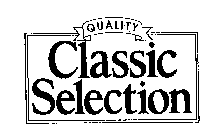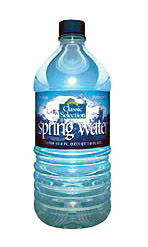7-Eleven Craps Out in TTAB 2(d) Opposition to "CLASSIC SELECTIONS" for Frozen Entrees
Opposer 7-Eleven threw snake eyes in this roll of the TTAB dice, losing its opposition to registration of the mark CLASSIC SELECTIONS for "frozen entrees consisting primarily of meat, fish, poultry or vegetables." The Board found the mark not likely to cause confusion with Opposer's registered logo mark shown immediately below (QUALITY disclaimed) for drinking water. The relative weakness of the marks and the differences in the parties' goods led the Board to dismiss the opposition. 7-Eleven, Inc. v. HEB Grocery Co., LP, 83 USPQ2d 1715 (TTAB 2007) [not precedential].

The board found that the "dominant and distinguishing portion" of Opposer's mark is the phrase CLASSIC SELECTION. The disclaimed word "QUALITY," which appears in smaller type, is less significant when the mark is considered as a whole. And despite Applicant HEB's dicey assertion that its mark has a different meaning than the words CLASSIC SELECTIONS in opposer's mark, the Board found the connotations to be identical.
As to the strength of the registered mark, HEB urged that the phrase CLASSIC SELECTION is weak (i.e., watered down?) and should be accorded very narrow protection. It pointed to third-party uses and registrations of the terms CLASSIC, CLASSICS, SELECT, SELECTS, and SELECTIONS, for a variety of food items. The Board took judicial notice of dictionary definitions of CLASSIC and SELECTION in concluding that "CLASSIC SELECTION" is not a "strong, arbitrary mark, but rather is clearly in the category of laudatory/suggestive." Nonetheless, noting Opposers's substantial sales under its mark during a 12-year period, and the lack of evidence of third-party use of the phrase CLASSIC SELECTION, the Board found that "the differences in the parties' marks are not sufficient to avoid a likelihood of confusion, when used on sufficiently related goods." However, it would not accord Opposers's mark "the broad scope of protection that would be given to a stronger, more arbitrary mark."

Turning to the issue of the relatedness of the goods, the Board observed that the goods are "obviously different in character" and that "[t]he differences in the goods are also reflected in how they are managed in the retail food industry, specifically, they are separated into different categories of goods and handled by different personnel in view of the different functionality of the goods and consumer's shopping habits."
7-Eleven argued that the goods are related "in that they are complementary, because they can be consumed together and are both in the category of 'convenience products.'" It pointed to third-party uses of and registrations for frozen food and drinking water under the same mark, and contended that "this relationship is further strengthened by the close proximity of the parties' goods in stores and grocery store advertisements." Finally, Opposer argued that frozen food entrees are within its natural zone of expansion.
The Board, however, found Opposer's approach to be "too broad:" "[w]hile drinking water may be consumed at the same time a heated frozen food entree is eaten, it is not used in combination with the entree in the same way bread and cheese are used together to complement each other."
As to the third-party uses and registrations, the Board noted that they cover "a broad array of goods, many of which are wholly unrelated, and, therefore, no conclusion can be drawn as to the realtionship between the goods in issue in this case." It agreed with Applicant HEB Grocery that:
"'[b]ecause nearly every type of product sold in modern grocery stores has a store brand alternative available for purchase' giving such evidence probative value would in effect create a 'per se rule that all goods available in modern supermarkets are related.'"
The Board pointed out that the subject application and registration are not limited to "store brand" products, but are more in the nature of a "national brands." As to Opposer's three examples of national brands, "two do not show use on frozen entrées (Dannon for drinking water and yogurt, and ODWALLA for drinking water and snack bars) and the third, NESTLE, is of little probative value in as much as, while NESTLE is used as the primary mark on the drinking water, the use of NESTLE on the frozen entrees is secondary, appearing on the side of the packaging with the primary mark STAUFFER'S displayed prominently on the front. Opposer's own witness testified that he was "not aware of any national brand used on both frozen entrees and bottled water."
As to channels of trade, although the record showed that frozen foods and drinking water are sometimes sold in close proximity, the same could be said of "charcoal and anti-freeze" in many convenience stores. Other testimony indicated that drinking water and frozen foods are positioned separately in grocery stores. The Board concluded that "the marketing conditions do not compel a finding of likelihood of confusion, given the inherent differences between these goods."
Finally, with regard to the zone-of-expansion argument, the Board cited Mason Engineering and Design Corp. v. Mateson Chemical Corp., 225 USPQ 956 (TTAB 1985), in ruling that 7-Eleven's expansion of another mark from ready-to-eat taquitos to frozen taquitos, or its use of the QUALITY CLASSIC SELECTION mark on other items, "does not support a finding that frozen food entrees would be perceived by consumers as falling within the natural zone of expansion of drinking water."
Considering all of the relevant du Pont factors, the board concluded that confusion is not likely, and it dismissed the opposition.
Text Copyright John L. Welch 2007.




0 Comments:
Post a Comment
<< Home